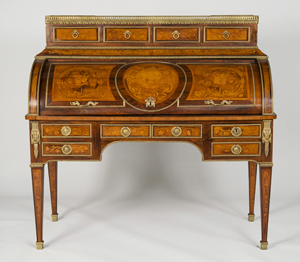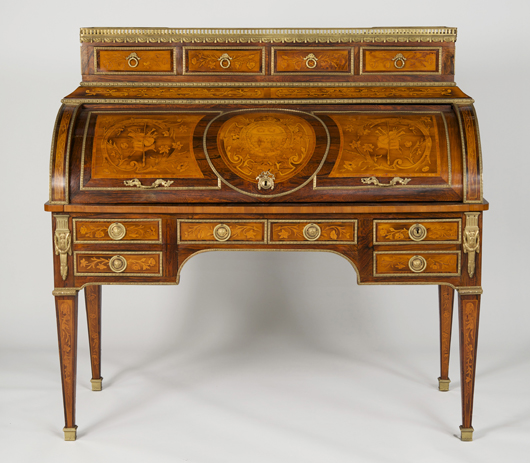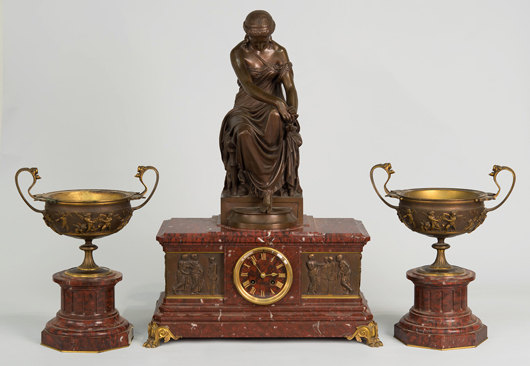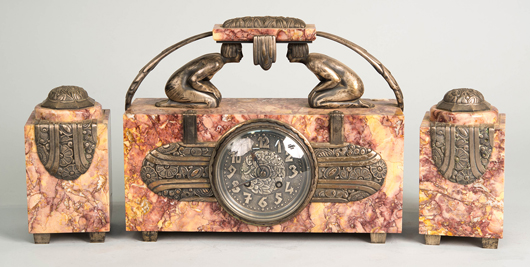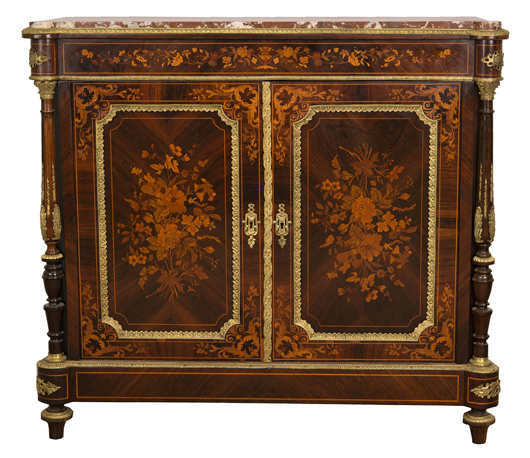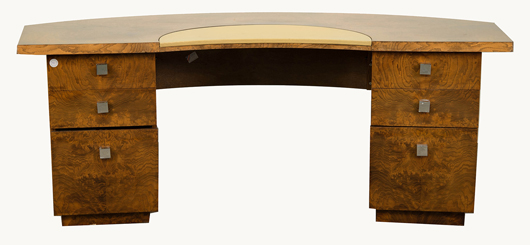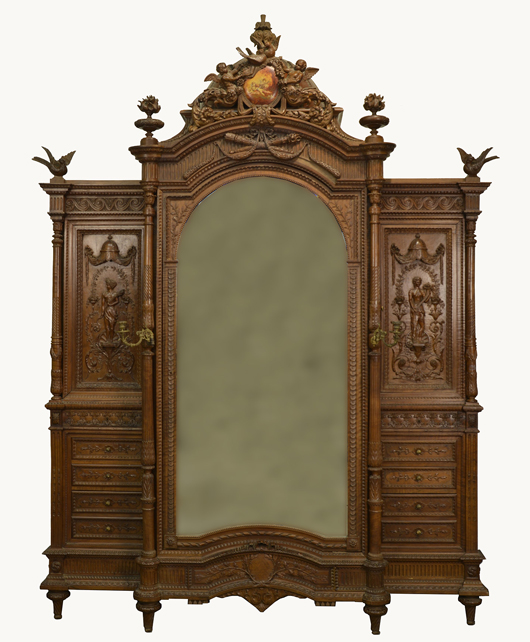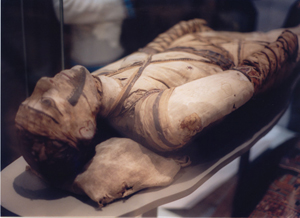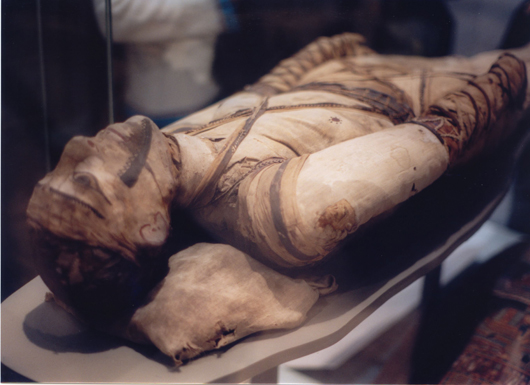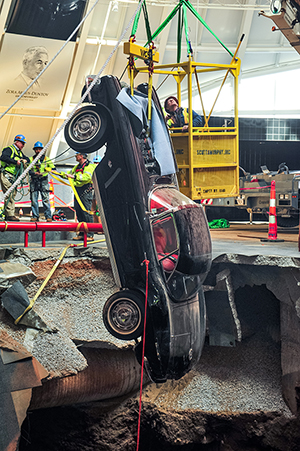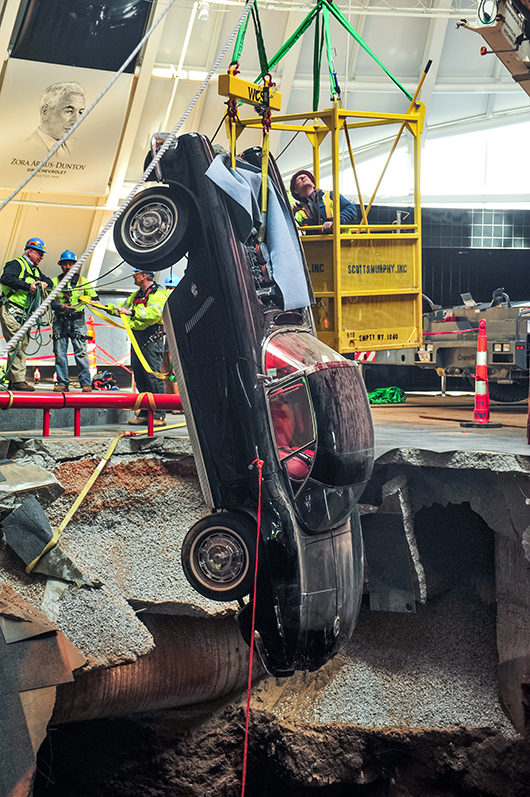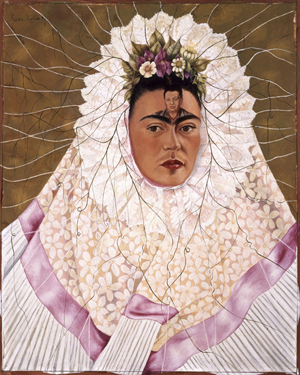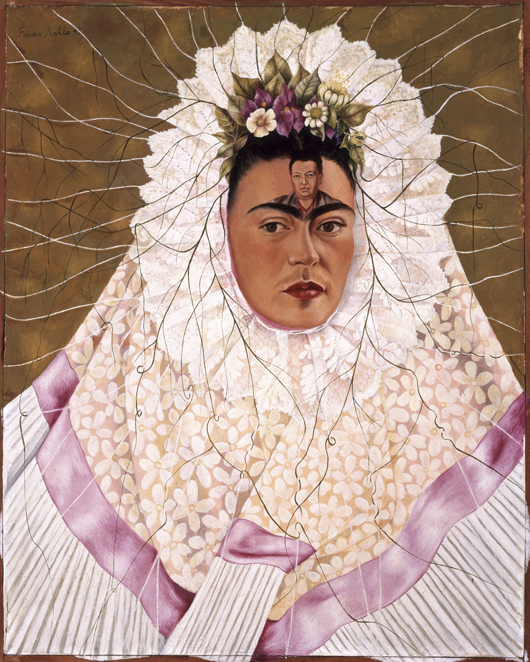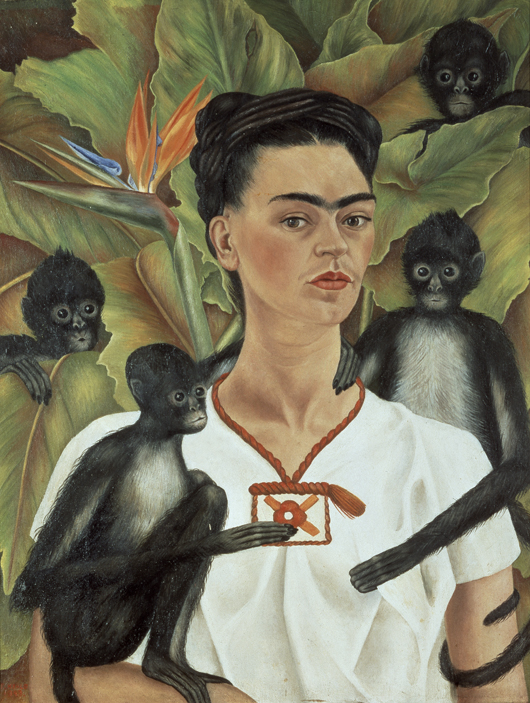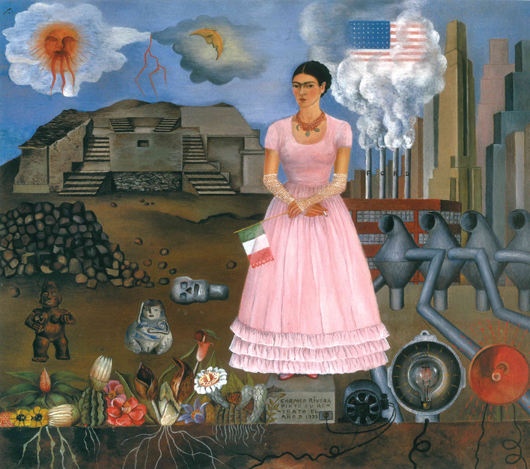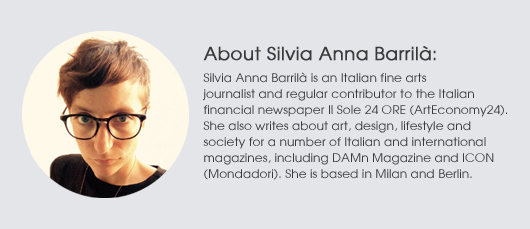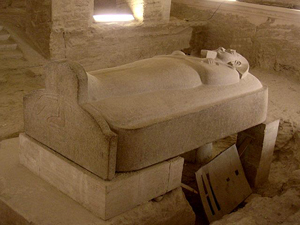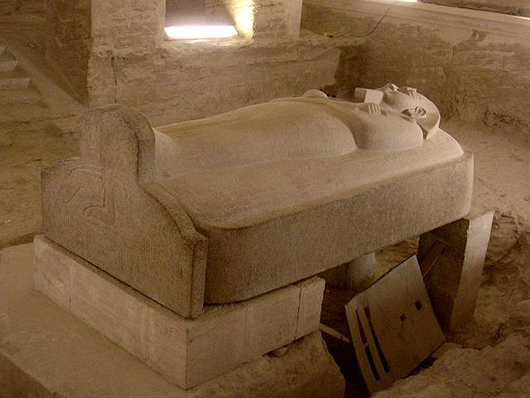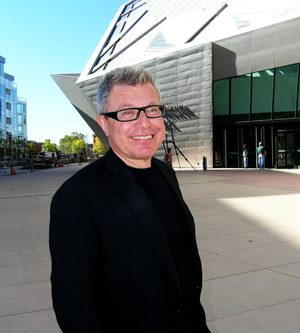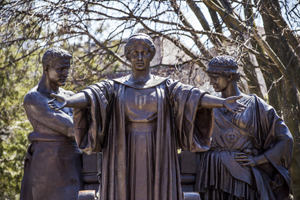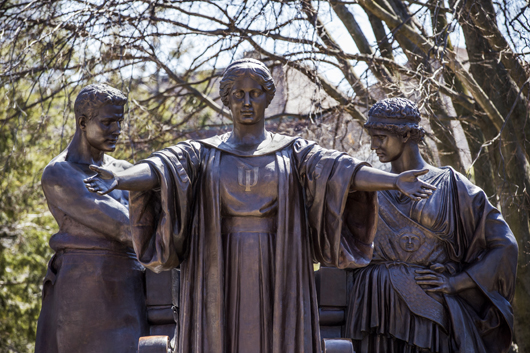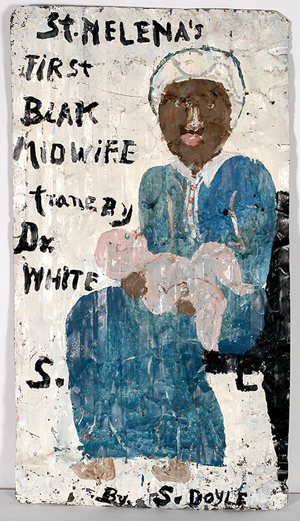
Lot 135 – Sam Doyle, ‘St. Helena’s First Blak Midwife Trane By Dr. White,’ circa 1980s, signed and titled, house paint on found roofing tin, 28in x 50in. Est. $25,000-$35,000. Slotin Folk Art image.
BUFORD, Ga. – The highly anticipated weekend sale featuring 1,151 lots of self-taught art, outsider art, Southern folk pottery, antique and anonymous folk art, as well as blues, jazz and rock memorabilia and will be held April 26-27, 2014 by Slotin Auction.
LiveAuctioneers.com will facilitate Internet live bidding.
This sale will feature premiere examples from the collection of Dr. Robert Bishop, author and former director of the Museum of American Folk Art, the collection of Jay Johnson, authority in 20th century folk art and owner of American’s Folk Heritage Gallery, New York, and the Gitter Family Folk Art Collection. Also, featured in this sale is the entire blues, jazz and rock estate of prominent Atlanta collector Walter Glenn. A fully illustrated auction catalog is available, live phone and absentee bidding will be executed and LiveAuctioneers.com will host Internet bidding.
And this auction will feature and exciting mix of offerings: Southern folk pottery, self-taught art masters, Southern furniture, historical and political items, religious items, quilts, African American carvings and paintings, international paintings, Native American art, portraits, trade signs, weather vanes, vernacular photography, erotica, canes, new discoveries and more. And for the first time, Slotin Auction will offer vintage rock posters, autographs, photos and memorabilia of jazz and blues greats, period sheet music, primitive instruments, and an original 1937 Robert Johnson Record.
“We have a stunning catalog, with some of the best examples by each artist and art form we have every put together in one auction. There is much to choose from,” said Steve Slotin of Slotin Auction. Whether you are looking for a museum-quality masterpiece or a starter piece for your collection, this sale will definitely have something for everyone.
The April 26 session will kick off at 10 a.m. Eastern with more 125 lots of face jugs, the crowd-pleasing expressions of Southern folk pottery, crafted by some of the most famous artisans in the field: 12 fantastic early face jugs by Lanier Meaders, including lot 74, a black-eyed rock tooth devil jug (est. $3,000-$5,000), and Lot 75, devil jack-o’-lantern (est. $3,000-$5,000); 10 fantastic jugs and pots by Arie and Cheever Meaders including Lot 58, a rare Evan Javan brown devil face jug (est. $1,000-$2,000); three gorgeous Edwin Meaders Roosters and two rare W.J. Gordy works.
A nice selection of antique and anonymous items will also hit the auction block including Lot 126, “a sugar chest in the shape of a desk,” circa 1825-50 (est. $10,000-$20,000), and Lot 128, an 1863 35-star American flag (est. $1,000-$2,000).
The list of top-tier artists is extensive in this sale. Six works by Sam Doyle kick off the Masterpiece section, including Lot 135, the iconic St. Helena’s First Blak Midwife Trane By Dr. White (sic), which is from the private collection of Chuck and Jan Rosenak and illustrated on page 110 in the Museum of America Folk Art Encyclopedia of Twentieth Century American Folk Art & Artists (est. $25,000-$35,000). Three works by William Hawkins will be sold. Of special note is Lot 141, Rider On Horseback (est. $20,000-$30,000). Lot 144, a rare Melrose Plantation quilt by Clementine Hunter from an important California estate, (est. $10,000-$15,000) will hit the auction block, along with stunning masterworks by Minnie Evans, Myrtice West, Chris Hipkiss, Mattie Lou O’Kelley, Vestie Davis, Ulysses Davis and Gustav Klumpp. A large Thornton Dial assemblage, Lot 165, is titled Fourth Of July Tiger (est. 20,000-25,000). Four works by Sister Gertrude Morgan are led by Lot 195, Seven-Headed Monster With Ten Horns, which was exhibited at the American Folk Art Museum, the New Orleans Museum of Art, and illustrated on page 36 of William A. Fagaly’s The Art of Sister Gertrude (est. 6,000-9,000). A rare construction by Herman Bridgers, Lot 164, Two Churchmens, illustrated on page 37 of American Primitive by Roger Ricco and Frank Maresca, is sure to stir up excitement (est. $5,000-$10,000). An amazing grouping of large, early numbered works by crowd favorite and folk art master Howard Finster, will hit the block, including Lot 168, Henry Ford Had a Vision, #4,865 (est. $8,000-$12,000) and Lot 175, According To The Bible We Can Bridle The Tongue, #353 (est. $2,000-$4,000
Other prominent artists featured in this sale round out a virtual who’s who in self-taught art with examples by Nellie Mae Rowe, Victor Joseph Gatto, Jon Serl, Lawrence Lebduska, Israel Litwak, Antonio Esteves, Uncle Jack Dey, Nan Phelps, Abraham Levin, John Roeder, Frank Jones, Clarence Woolsey, Raymond Coins, Justin McCarthy, Jack Savitsky, Chelo Gonzalez, Johnnie Swearingen, Herbert Singleton, Kathy Jakobsen, Bettye Williams, Charlie Willeto, Lee Godie, Uncle Pete Drgac, Purvis Young, Jimmy Lee Sudduth, Sulton Rogers, and an incredible new discovery, Oscar T. Nelson, who depicted scenes from the Euclid Beach (Ohio) Amusement Park on Lake Erie in the 1950s.
The Sunday sale will kick off with the estate of Walter Glenn beginning with Lot 739 and a collection of vintage first-run concert posters including a Stanley Mouse and Alton Kelley design for Howlin Wolf At the Avalon, a concert that was canceled (Lot 741, est. $2,000-$3,000). The highly anticipated, Lot 766. Robert Johnson Walkin’ Blues and Sweet Home Chicago, full-range recording Vocalion, #03601, dated 1937, is estimated at $4,000-$6,000. Glenn’s world-famous autograph collection follows with rarities such as John Coltrane, Charlie Parker Louis Armstrong, Thelonious Monk, Willie Dixon, Muddy Waters, Miles Davis, Ray Charles Little Walter, B.B. King, T. Bone Walker, Sister Rosetta Tharpe and of special note, Lot 778, a seminude photo of Pearl Bailey and signature card, (est. $800-$1,200). Sunday’s lots will also include a collection of primitive instruments, erotica including nudes of Betty Page and original Paul “Kurt Schnurr” Kirchner illustration art for Screw Magazine, native baskets, Haitian paintings, Native American folk art and even some prison art.
Slotin Auction specializes in bringing the strange, the unusual and the vanishing America to auction.
For details contact Slotin Auction by calling 770-532-1115 or 404-403-4244, or email them at auction@slotinfolkart.com.
ADDITIONAL LOTS OF NOTE

Lot 135 – Sam Doyle, ‘St. Helena’s First Blak Midwife Trane By Dr. White,’ circa 1980s, signed and titled, house paint on found roofing tin, 28in x 50in. Est. $25,000-$35,000. Slotin Folk Art image. 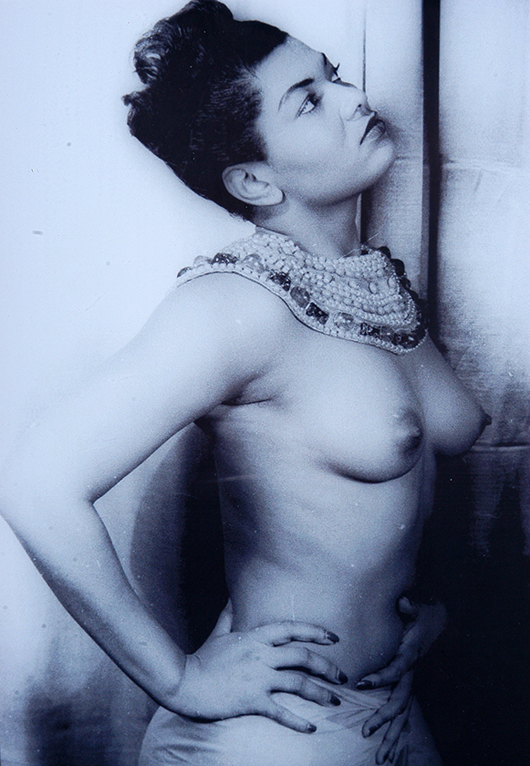
Lot 778 – Pearl Bailey,‘seminude photograph with signature card.’ Photo is 7.5in x 10in. Signature card is 4.5in x 3.5in. Est. $800-$1,200. Slotin Folk Art image. 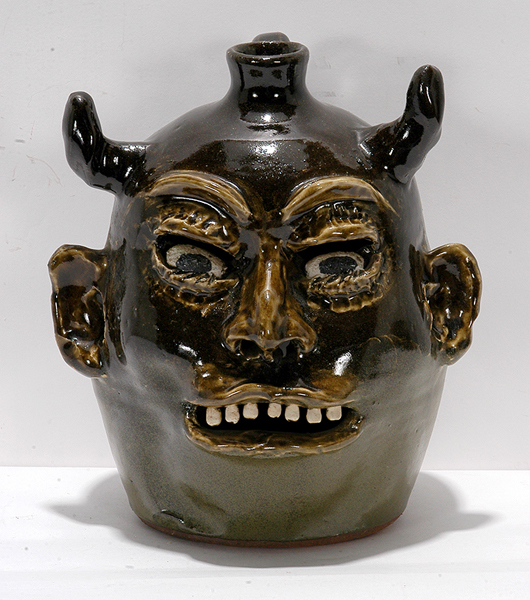
Lot 75 – Lanier Meaders, devil jack-o’-lantern face jug. c. 1970s, signed, opening in back for candle, 10in high. Est. $3,000-$5,000. Slotin Folk Art image. 
Lot 141 – William Hawkins, ‘Rider On Horseback,’ 1988, Signed and dated with Hawkins’ birthdate, enamel on Masonite, image 48in x 36in. Est. $20,000-$30,000. Slotin Folk Art image. 
Lot 766 – Robert Johnson, ‘Walkin’ Blues’ and ‘Sweet Home Chicago,’ full-range recording, Vocalion #03601, dated, 1937. Est. $4,000-$6,000. Slotin Folk Art image. 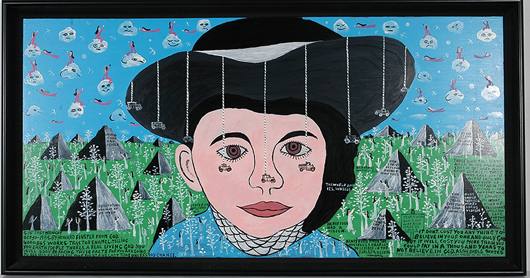
Lot 168 – Howard Finster, ‘Henry Ford Had a Vision, #4,865.’ 1985, signed, titled, numbered and dated, tractor enamel on board, size with frame 50in x 27in. Est. $8,000-$12,000. Slotin Folk Art image.


